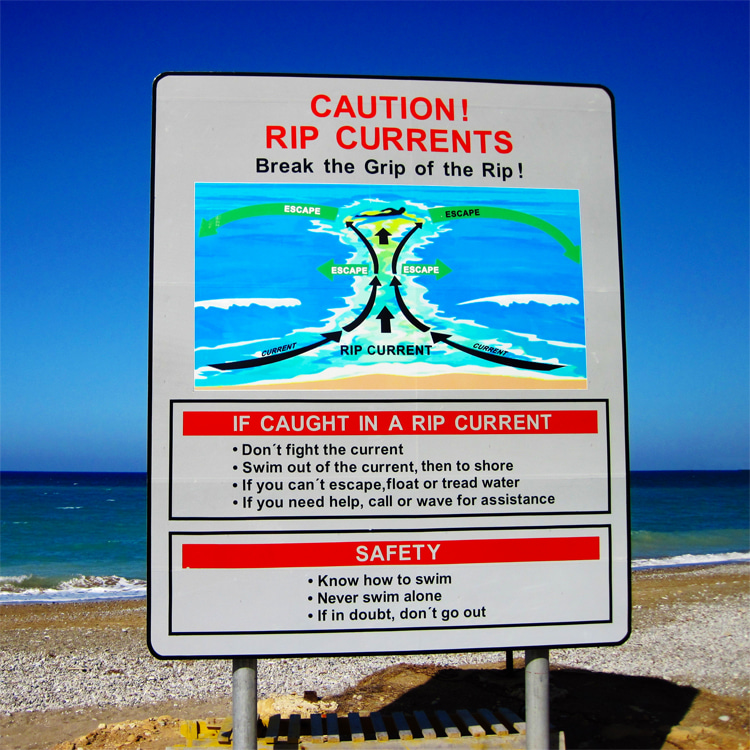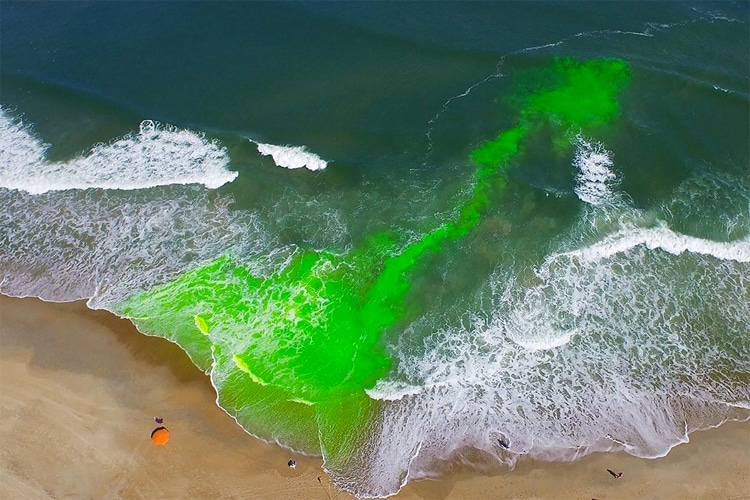Rip currents are responsible for hundreds of drownings and more than 100,000 lifeguard rescues on world beaches every year. Learn how to avoid and survive these mysterious ocean rips.
Water moves everywhere, so rips are strong currents, just like river currents.
All beaches have their own particular currents. They're dangerous and deadly to swimmers but also to all wave riders.
On unpatrolled beaches, surfers tend to rely on their personal knowledge and their floatation crafts, i.e., their surfboards.
However, rip currents will move anything and anyone.
If maritime conditions suddenly change, new water channels will flow, pushing you to new areas.
If you're tired after two hours of waves, a rip will certainly defeat you for good.
"The rip will not pull you under the water, and your body has a natural ability to float," writes Rob Brander in his book "Dr Rip's Essential Beach Book."
Being in a rip usually doesn't feel like anything because you are just going with the flow."
Types of Rips
There are several types of rip currents:
- Fixed rips: The most common ocean rip. It sits in deep channels snuggled between shallow sand bars. These currents can stay in the same place for days, weeks, and even months. Fixed rips appear as dark gaps of calmer water between breaking waves and whitewater;
- Flash rips: They move around all over the place, popping up and disappearing, and usually last for a few minutes. They are dangerous and form in larger surf. Flash rips flow quickly and are impossible to predict;
- Permanent rips: They are influenced by topography, so they sit and reappear in the same spot all the time. They tend to flow further offshore than fixed rips. Look for dark channeling gaps;
- Megarips: They are big, fast, and rare. They only appear with storms and large swells;
- Swash rips: They combine the uprush of water from a broken wave up the beach and its subsequent backwash downward. They may carry people into deep water beyond the shore break;
How to Spot a Rip Current
Now it's time to find out what it means to be caught by a rip current.
Here's how to identify a potentially hazardous rip current:
- If you see areas in the ocean where the waves aren't breaking;
- Areas where there is a lot of foam, seaweed, or debris moving away from the shore;
- Dark, discolored water being pulled offshore;
- If there are breaks in between sandbars;
- Areas around human-made structures like jetties and piers;

How to Avoid Rips: Memorize the Rules
One of the most important rules is never to swim against the rip. Small rips will flow faster than the average person can swim. You'll get tired and start panicking.
If you get caught in a rip current, you've got four rational alternatives.
First, stay afloat and signal for help. Then, if possible, swim towards the side of the rip, keeping in mind that rips are quite narrow.
If you still can't get out of the rip, look for whitewater and breaking waves.
"Whitewater is good because it means the water is shallower, and you may be able to stand up," adds Brander.
"Whitewater will also bring you back to shore. When it comes to most rips, 'white is nice, green is mean.'"
Finally, if you just can't swim out, let the rip take you out the back until it stops. Then, you'll be able to swim back to the beach in an alternative way.
So, here's a recap:
- Check with the lifeguards: If a lifeguard is on duty, always check before entering the water where the nearest one is to you;
- Never go in the water alone: Always have a buddy to go in the water with who can alert the lifeguards if anything happens to you;
- Monitor the surf: Always check forecasts of weather conditions and surf reports to see what the water will be like;
- Know your flags: Always check where you can enter the water. For swimmers and bodyboarders, this is different from handcraft sports like surfing and kayaking;
- Know your ability: If you know you aren't a strong swimmer, don't go in any deeper than you can manage safely;
How to Escape a Rip Current
Here's what you've got to do if you get caught in an ocean rip:
- If you ever find yourself caught in a rip current, the number one thing you'll want to remember is to stay calm. Panicking can exhaust you, and you need to conserve energy;
- If you can, alert the lifeguard by putting your fist in the air. This is an international distress signal and should be used alongside shouting for help;
- If you're able, you can swim perpendicular to the shoreline to get out of the current. As the water flows backward, this can get you out of the current and back to the shore;
- Never fight the current if you are unable to swim and are getting tired. Let the current carry you out to sea until you reach the point where it weakens. Rip currents typically stay close to shore and weaken just beyond the line of breaking waves;
- Keep hold of anything that floats, such as a surfboard or SUP, to prevent exhaustion;
